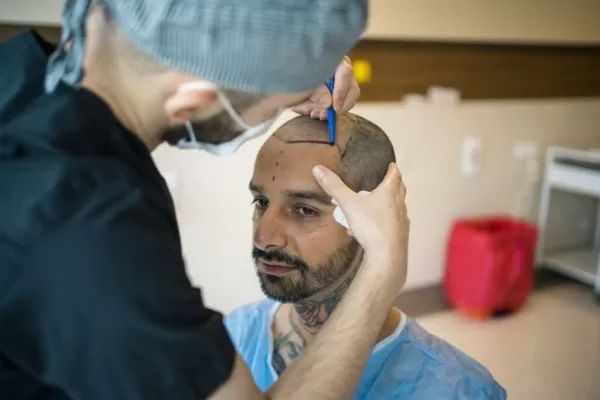
Hair loss is a common concern for both men and women, with many looking for advanced and effective solutions. Among the cutting-edge methods available today, stem cell hair transplant stands out as a promising solution to stimulate natural hair growth. This innovative technique harnesses the regenerative power of stem cells to rejuvenate hair follicles, giving patients a fuller, thicker, and healthier scalp. But how exactly does it work? In this article, we will explore the science behind stem cell hair transplants in Dubai(زراعة الشعر بالخلايا الجذعية في دبي), the benefits, and how they contribute to hair regeneration.
What is Stem Cell Hair Transplant?
A stem cell hair transplant is a revolutionary approach to treating hair loss, combining stem cell therapy and hair restoration procedures. The procedure involves extracting stem cells from the patient’s own body, often from adipose (fat) tissue or bone marrow, and processing them to isolate the stem cells. These cells are then reintroduced into the scalp, where they stimulate dormant hair follicles and encourage them to grow new, healthy hair.
The concept behind this method is to leverage the body's natural regenerative abilities to revive hair follicles that may have stopped producing hair. The stem cells promote the healing process, accelerate cell growth, and even reduce inflammation, leading to improved hair follicle health.
How Does Stem Cell Hair Transplant Promote Growth?
The key factor in promoting hair growth through stem cell hair transplants is the ability of stem cells to regenerate and repair tissues. Stem cells are unique in their capacity to transform into various types of cells, including those needed for hair follicle regeneration.
When stem cells are injected into areas affected by hair thinning or baldness, they begin working on a cellular level to stimulate the growth of new hair. They help in restoring the function of weakened hair follicles by providing essential nutrients, reducing inflammation, and encouraging cell turnover. This process enables the follicles to become more active, promoting the natural growth of hair in areas where thinning or baldness had occurred. As a result, individuals can expect healthier, thicker, and more voluminous hair.
The Role of Stem Cells in Hair Follicle Regeneration:
Hair follicles are complex structures that require various factors to remain healthy and continue producing hair. As we age or experience hair loss due to genetic factors, hormonal changes, or other causes, hair follicles can become dormant or even shrink. This leads to thinning hair and, in severe cases, baldness.
Stem cells have the remarkable ability to rejuvenate these dormant follicles. When stem cells are injected into the scalp, they promote the regeneration of the hair follicle's matrix and dermal papilla, the parts responsible for hair growth. Stem cells can also increase the density of hair follicles, which leads to stronger and thicker hair over time.
How Stem Cell Hair Transplants Compare to Other Hair Restoration Methods
While traditional hair transplants, such as follicular unit extraction (FUE) or follicular unit transplantation (FUT), have long been popular methods for treating hair loss, stem cell hair transplants offer several advantages over these techniques.
One significant difference is that stem cell therapy promotes natural hair growth by addressing the underlying causes of hair thinning, rather than merely relocating healthy follicles from one part of the scalp to another. This method can also help regenerate hair follicles that might not be suitable for traditional hair transplant methods.
Additionally, stem cell transplants are minimally invasive, with less downtime and fewer risks compared to surgical hair transplants. The regenerative properties of stem cells also mean that the results may be more long-lasting, with hair growth continuing to improve over several months.
The Benefits of Stem Cell Hair Transplants:
There are numerous benefits to choosing a stem cell hair transplant, which is why it’s becoming increasingly popular among people seeking a more natural solution to hair loss. Some of the main advantages include:
Natural Results: Because stem cells use the body's natural healing processes, the results are often more natural-looking and seamless. The hair grows in a way that mimics your natural hair growth pattern.
Minimal Downtime: Unlike traditional hair transplants that require several days or even weeks of recovery, stem cell hair transplants typically involve a shorter recovery period, with patients able to resume regular activities faster.
Long-Lasting Results: As stem cells continue to rejuvenate hair follicles over time, the results tend to improve gradually. The hair that grows is stronger and thicker, and the effects can last for years.
Non-Surgical Approach: Since stem cell transplants are minimally invasive, there’s no need for the cutting and stitching associated with more traditional methods. This reduces the risk of complications and leads to faster healing.
The Science Behind Stem Cell Hair Transplants:
The science behind stem cell hair transplants lies in the cells’ ability to transform into various types of tissue. Stem cells can differentiate into the types of cells needed to restore and revitalize hair follicles, improving their functionality.
This regenerative process begins as the stem cells are injected into the scalp. They stimulate the dermal papilla, the part of the hair follicle responsible for producing the necessary growth factors. Stem cells also help increase blood flow to the scalp, ensuring that the follicles receive the nutrients they need to thrive. Over time, these processes result in the growth of new hair, with many patients experiencing noticeable improvement within three to six months after the procedure.
Potential Risks and Considerations:
While stem cell hair transplants are generally safe and effective, there are a few considerations to keep in mind before undergoing the procedure. Like any medical treatment, there are risks, including infection, inflammation, and the possibility that the procedure may not deliver the expected results.
It’s important to have realistic expectations and to understand that the success of the treatment depends on various factors, including the patient’s overall health, the stage of their hair loss, and the quality of the stem cells used in the procedure. Consulting with a medical professional who specializes in regenerative treatments can help you understand whether stem cell hair transplant is the right choice for you.
Conclusion:
In conclusion, stem cell hair transplant offers a cutting-edge, minimally invasive solution to hair loss by promoting the growth of new, healthy hair. By utilizing the regenerative abilities of stem cells, this treatment helps rejuvenate hair follicles, improving the health, thickness, and density of hair over time. Though it may not be suitable for everyone, stem cell hair transplants represent an exciting advancement in the field of hair restoration, offering patients a more natural and long-lasting alternative to traditional methods.













